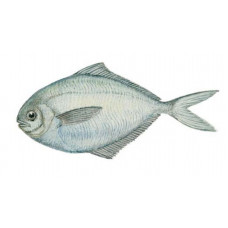Latin name
Peprilus triacanthus
Other names
American butterfish, Atlantic butterfish, dollarfish, pumpkin scad, sheepshead; French: stromaté fossette; Spanish: palometa pintada.
Identification
Fish of this species are usually full-bodied, flattened from the sides, somewhat round or rounded, with blunt noses and small mouths with weak teeth. There is no pelvic fin, a long continuous dorsal fin, long pectoral fins, and tiny cycloid scales. The caudal fin is almost as long as the dorsal fin and is deeply bifurcated. This fish is lead-blue in color on top, with pale flanks and a silvery belly. It often has irregularly shaped dark spots.
Distribution
Occurs in the western Atlantic Ocean, occurring in the waters off eastern Newfoundland and the Gulf of St. Lawrence in Canada, extending down the North American coast to Palm Beach, Florida. Also found in the Gulf of Mexico.
Habitat
Butterflyfish live and feed in large, dense waters along the coast from 40° to 74 °F. Can live in brackish waters and may move to deeper waters in winter. Juveniles are usually associated with floating weeds and jellyfish.
Size
It is usually 6 to 9 inches, although some go as high as 12 inches. They can weigh anywhere from 1.75 to 20 ounces.
Life history and Behavior
Relatively little is known about the American butterfish. It is an important food source and a common species. It wanders in small groups or loosely organized flocks, preferring areas with sandy bottoms, muddy, often coming close to shore. During the summer months it does not go deeper than 10 to 15 fathoms, but in winter and early spring it can be found at depths of 100 to 115 fathoms below the surface.
Food and feeding habits
Feeding mainly on jellyfish, butterflyfish are among the few fish that eat such low-nutrient food. Their diet also consists of a variety of small worms, crustaceans, squid, shrimp, fish.
Reproduction
Sexual maturity occurs at 2 years of age at a length of about 8 inches. Spawning occurs once a year from May to August in coastal waters. Eggs float freely until they hatch within 2 days. Juveniles enter bays or estuaries to hide in floating weeds and among jellyfish tentacles for protection from predators.
| Classification | |
| Phylum | Chordata |
| Class | Actinopterygii |
| Squad | Scombriformes |
| Family | Stromateidae |
| Genus | Peprilus |
| Species | P. triacanthus |
| Features | |
| Conservation status | No information |
| Habitat | Littoral |
| Life span, years | No information |
| Maximum body weight, kg | 0.57 |
| Maximum length, cm | 30.48 |
| Sailing speed, m/s | No information |
| Threat to people | Edible |
| Way of eating | Planktonophage |
Butterfish
Tags: Butterfish



